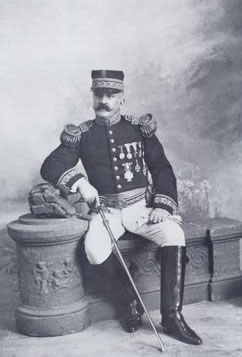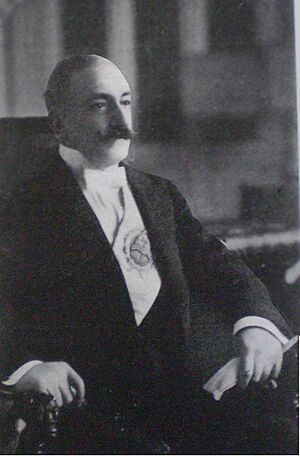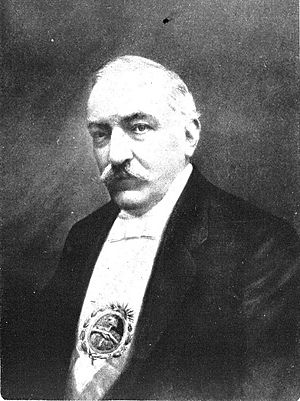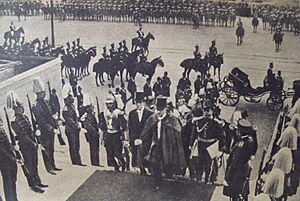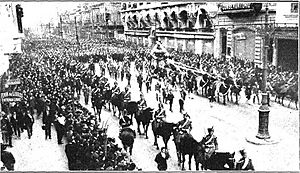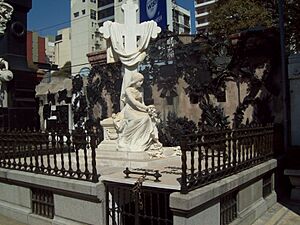Roque Sáenz Peña facts for kids
Quick facts for kids
Roque Sáenz Peña
|
|
|---|---|
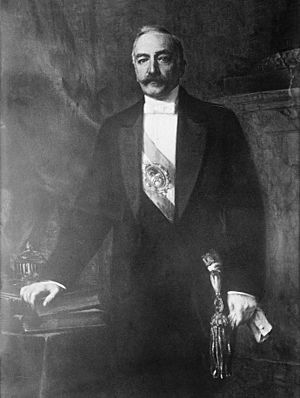 |
|
| President of Argentina | |
| In office 12 October 1910 – 9 August 1914 |
|
| Vice President | Victorino de la Plaza |
| Preceded by | José Figueroa Alcorta |
| Succeeded by | Victorino de la Plaza |
| Minister of Foreign Affairs and Worship | |
| In office 30 June 1890 – 4 August 1890 |
|
| President | Miguel Juárez Celman |
| Preceded by | Amancio Alcorta |
| Succeeded by | Eduardo Costa |
| Personal details | |
| Born |
Roque Sáenz Peña Lahitte
19 March 1851 Buenos Aires, Argentina |
| Died | 9 August 1914 (aged 63) Buenos Aires, Argentina |
| Resting place | La Recoleta Cemetery, Buenos Aires |
| Political party | National Autonomist Party |
| Spouse |
Rosa Isidora González Delgado
(m. 1887) |
| Children | 1 |
| Parents | Cipriana Lahitte (mother) Luis Sáenz Peña (father) |
| Alma mater | University of Buenos Aires |
| Profession | Lawyer |
| Signature | |
| Military service | |
| Allegiance | |
| Branch/service | Argentine Army Peruvian Army |
| Rank | Brigadier General (of Peru) |
| Battles/wars | Revolution of 1874 War of the Pacific |
Roque José Antonio del Sagrado Corazón de Jesús Sáenz Peña Lahitte (born March 19, 1851 – died August 9, 1914) was an important Argentine politician and lawyer. He served as the President of Argentina from October 12, 1910, until his death in 1914.
Roque Sáenz Peña was the son of a former president, Luis Sáenz Peña. He was known for being a "modernist" within his political group, the National Autonomist Party.
His most famous achievement was creating Law 8871, known as the "Sáenz Peña Law". This law completely changed how elections worked in Argentina. It made voting secret, available to everyone (men over 18), and required people to vote. This law helped stop unfair elections by powerful groups and allowed new political parties, like the Radical Civic Union, to rise in Argentina's first truly free elections.
Contents
Early Life and Education
Roque Sáenz Peña was born to Luis Sáenz Peña and Cipriana Lahitte. His family had a history in politics. He went to the National School of Buenos Aires for his high school studies. In 1875, he became a doctor of law, which means he finished his law degree.
In 1874, during a time of political unrest, he helped defend the government as a Captain. After this, he was promoted but decided to leave the military. He was against Bartolomé Mitre and joined the Autonomist Party. In 1876, he was elected as a Deputy in the Legislature of the Province of Buenos Aires. At just 26 years old, he became the president of this group, making him one of the youngest leaders there.
In 1877, he helped start the Republican Party with other famous figures like Leandro N. Alem and Hipólito Yrigoyen. In 1878, he left his political position and took a break from politics for a while.
On February 4, 1887, he married Rosa Isidora González Delgado. Their wedding took place in the Basilica of Our Lady of Pilar in Buenos Aires.
Military Service in the War of the Pacific
The War of the Pacific was a conflict between Chile and an alliance of Bolivia and Peru. Argentina secretly joined this alliance. The fight was over land in the Atacama Desert, which had valuable minerals.
During this war, Sáenz Peña left Argentina to fight alongside the Peruvian army. He served as a lieutenant colonel in the Peruvian Army. After his commanders were killed in the Battle of Arica, he took charge of a Peruvian division. He was captured by the Chilean forces after the battle and held as a prisoner for six months.
Rising to Power
When Sáenz Peña returned to Buenos Aires, he was appointed as a sub-secretary in the Ministry of Foreign Relations in 1880. He later left politics again but came back in 1887 to serve as a minister in Uruguay. He represented Argentina at the 1888 Montevideo Congress. Here, he strongly defended Argentina's legal and political beliefs.
Sáenz Peña also represented Argentina at the first Pan American Conference in 1889. He traveled a long way to attend this meeting in Washington. The Argentine group initially refused to attend the opening because they felt a diplomatic rule was broken. However, they attended the second session. During the conference, Sáenz Peña spoke against a free trade area for the Americas. Despite his arguments, the idea was supported by most nations, but Argentina, Chile, and Bolivia voted against it.
As foreign minister, Sáenz Peña traveled the world, working to benefit Argentina. He also attended important events, like the wedding of Spanish king Alfonso XIII in 1906. He worked with the Italian government to increase trade and shared economic news about Argentina with other European governments and businesses. Before becoming president, Sáenz Peña was an ambassador to Spain (1906–1907) and Italy (1907–1910).
His Time as President
Roque Sáenz Peña became president of Argentina after an election on March 13, 1910. He wasn't even in Argentina during the election; he was serving as ambassador to Italy. He won with almost all the votes.
Before he became president, Sáenz Peña met with the outgoing president, José Figueroa Alcorta, and the opposition leader, Hipólito Yrigoyen. In this meeting, Yrigoyen promised to stop revolutionary actions. Sáenz Peña, in turn, promised to create a new election law to make voting fair and prevent fraud.
Important Changes During His Presidency
On October 12, 1910, Roque Sáenz Peña officially became president. In his first speech, he said his foreign policy would be "friendship for Europe and fraternity for America." He became president at a time of tension, promising to reform elections and prevent a revolution.
In 1912, a new law was passed to help develop national territories. This law led to the building of many new railway lines. These railways helped people settle further inland in areas like Chaco, Formosa, Río Negro, Chubut, and Santa Cruz. A railway even reached Posadas, the capital of Misiones.
On August 10, 1912, he signed a decree to create the Military Aviation School (EMA). This was an important step for military aviation in Argentina.
The Farmers' Protest: The Cry of Alcorta
In June 1912, a large protest happened among tenant farmers. These farmers rented land and were upset about their contracts with landowners. This protest, known as the Grito de Alcorta, spread across the Pampas region. It led to a big reduction in rents for farmers. This event showed that the rural middle class, made up of farmers, was becoming an important force in national politics.
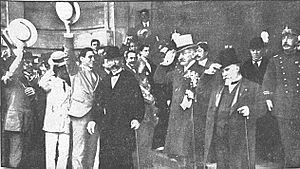
The Famous Sáenz Peña Law
Sáenz Peña strongly believed in democracy. He thought that if people could vote freely, they would choose the best leaders. He also worried about social issues and wanted to prevent workers from turning to extreme ideas like anarchism or socialism. He also noticed that many foreigners in Argentina did not participate in politics, and he wanted them to feel more connected to society. Because of these reasons, he supported a political reform based on fair and free voting.
Why the Law Was Needed
In the past, people voted aloud, which meant they could be pressured. To make voting truly free, Sáenz Peña proposed secret voting using sealed envelopes. To make sure everyone could vote, he also made it universal (for men) and mandatory. The military records were used to create the voter lists. Before this law, only about 20% of eligible voters actually participated in elections.
Sáenz Peña presented his idea to Congress, saying: "I have told my country all my thoughts, my convictions and my hopes. May my country listen to the word and the advice of its first president, let the people vote."
How the Law Changed Voting
The Minister of the Interior, Indalecio Gómez, was in charge of writing the law and defending it in Congress. He faced strong opposition from conservative politicians who benefited from the old system. Many lawmakers tried to stop the reform.
Approving the Law
After a month of debate in the Chamber of Deputies and a week in the Senate, the Sáenz Peña Law was approved. It became official on February 13, 1912.
What the Law Achieved
This law was a huge step forward for its time. It allowed many more people to participate in elections. However, it was not completely universal yet, as women and foreigners (who made up a large part of society) still could not vote. Even though they couldn't vote, their numbers were counted when deciding how many representatives each area could elect.
The first time the law was tested was in a provincial election in Santa Fe. The government made sure the election followed the new law. The UCR party, which had previously refused to participate, joined and won. Soon after, they won again in elections for deputies in the City of Buenos Aires. In that election, 62.85% of registered voters participated, and the Socialist Party also grew significantly.
His Final Years and Death
Roque Sáenz Peña's health was not good when he became president, and it got much worse starting in 1913. Because of his health, he took a leave of absence and let Victorino de la Plaza take over his duties temporarily.
Sáenz Peña was the only president who actually lived in the Casa Rosada (the presidential palace) because his health made it hard for him to travel from his home. He made a part of the palace his home, adding heating, rugs, and comfortable furniture. In his last days, Sáenz Peña said, "I have lost almost all my friends, but I have governed for the Republic."
He died on August 9, 1914, just under four years after becoming president. He was buried the next day in the Recoleta Cemetery in Buenos Aires.
Legacy
Today, Roque Sáenz Peña is remembered for his important electoral reform and his strong efforts to protect Argentina's interests around the world. In Argentina, especially in Buenos Aires, he is highly honored. Many streets, avenues, and towns are named after him, such as:
- The President Roque Sáenz Peña Avenue in Buenos Aires.
- The Sáenz Peña subway station in Buenos Aires Province.
- The city Presidencia Roque Sáenz Peña in Chaco.
- The department Presidente Roque Sáenz Peña in Córdoba.
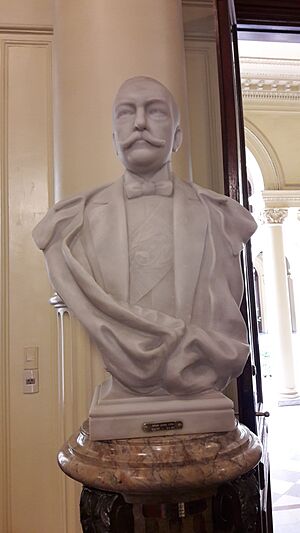
His role as a soldier is also remembered in Peru, where many cities have streets named Sáenz Peña and monuments in his honor. In Rio de Janeiro, Brazil, a square is named Plaza Sáenz Peña.
Images for kids
See also
 In Spanish: Roque Sáenz Peña para niños
In Spanish: Roque Sáenz Peña para niños



